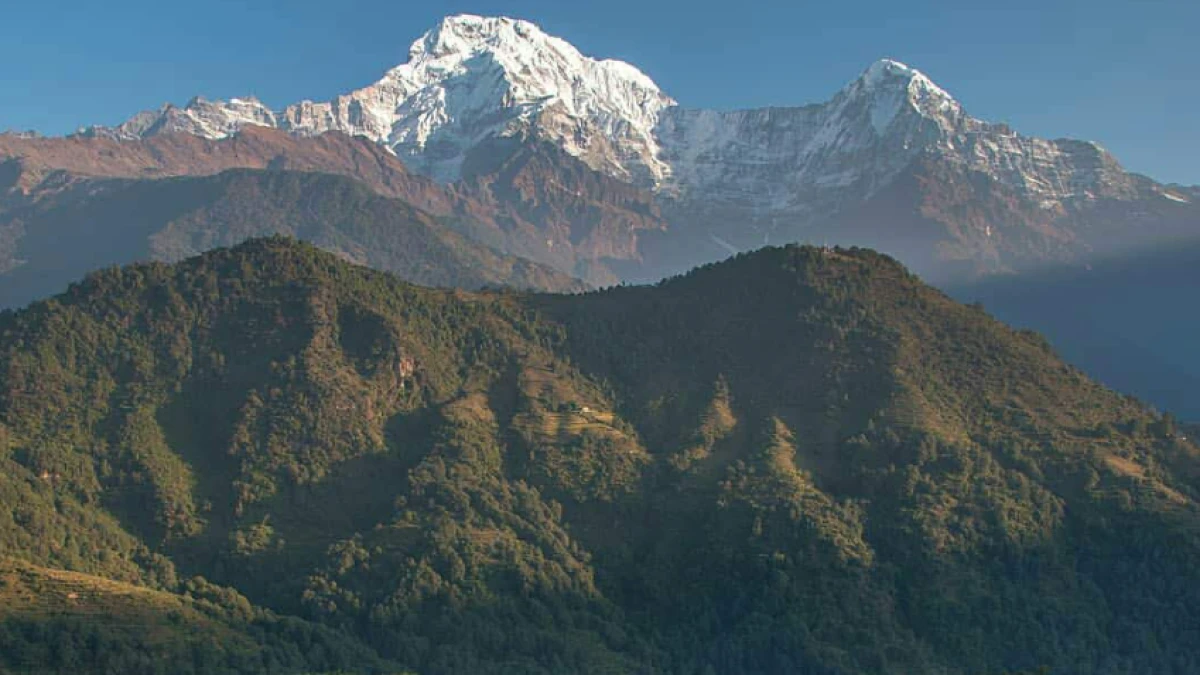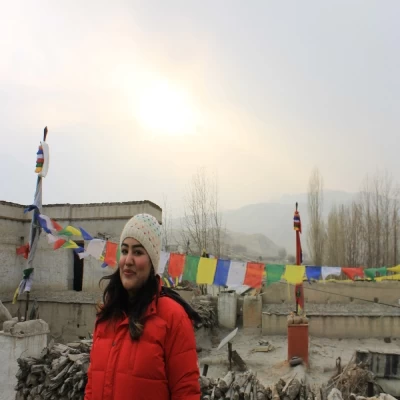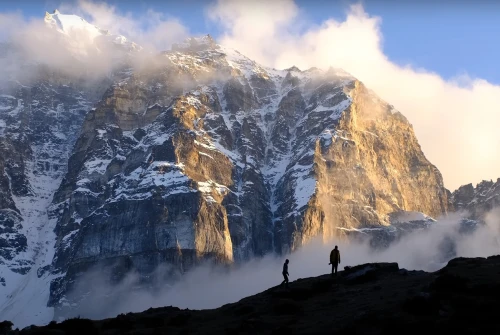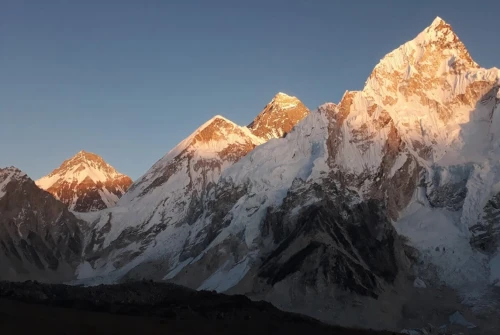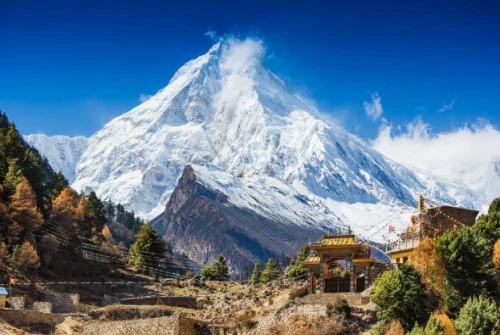Mardi Himal Trek Monthly Weather Guide Overview
The Mardi Himal Trek is one of Nepal’s most enchanting short treks, offering breathtaking views of the Annapurna Range, Machhapuchhre (also known as the Fish Tail), and Hiunchuli peaks. Situated in the heart of the Annapurna region, this trail offers trekkers a diverse range of landscapes, from lush rhododendron forests to alpine meadows and snow-capped ridges. The journey takes around 5 to 7 days and is perfect for those seeking a peaceful alternative to the busier Annapurna Base Camp route.
Weather plays a crucial role in shaping your Mardi Himal trekking experience. Understanding the Mardi Himal Trek monthly weather helps you choose the ideal season for clear mountain views, comfortable temperatures, and fewer challenges. Each season transforms the trail, offering a new charm, from the blooming spring flowers to the serene winter landscapes.

Is the Mardi Himal Trek Safe?
Yes, the Mardi Himal Trek is considered safe for beginners and experienced trekkers alike, as long as basic precautions are taken. The trail is well-marked and moderately steep in sections, but not technically difficult. However, safety highly depends on seasonal conditions slippery monsoon trails and freezing winter temperatures can increase risks.
The trek reaches an altitude of about 4,500 meters (14,763 ft) at Mardi Himal Base Camp. While the altitude is moderate, mild altitude sickness can occur if trekkers ascend too quickly. Proper acclimatization, hydration, and avoiding alcohol help minimize risks. Hiring a local guide enhances safety since they are trained to handle altitude-related issues and unpredictable mountain weather.
During monsoon months, landslides and leeches can make the lower trails tricky, while in winter, some sections may be covered in snow. Nonetheless, with good preparation and awareness, Mardi Himal remains one of Nepal’s safest short treks.
Mardi Himal Weather Month by Month
Understanding the Mardi Himal weather month by month helps trekkers prepare for temperature changes, rainfall, and visibility across seasons. Below is a detailed breakdown of what to expect each month along the trail.
Spring (March–May): The Blooming Season for Mardi Himal Trek
Spring is often considered the most picturesque time for the Mardi Himal Trek. The forests along the trail come alive with blooming rhododendrons, magnolias, and orchids, painting the hillsides in vibrant colors. The weather remains mild, with daytime temperatures ranging from 10°C to 20°C (50°F to 68°F) at lower altitudes and cooler conditions at higher camps.
Skies are generally clear, offering magnificent views of Annapurna South and Machhapuchhre. This season also provides stable weather, minimal rainfall, and pleasant trekking conditions. Since spring attracts both domestic and international trekkers, it’s wise to book tea houses in advance.
Spring is also perfect for photographers, as the natural lighting and flower-filled trails create postcard-worthy moments at every turn.
Mardi Himal Trek in March
March marks the arrival of spring, bringing life back to the forests with blooming rhododendrons and lush greenery. The weather becomes milder, making it one of the best months for trekking. Daytime temperatures are pleasant at 10°C to 18°C, while nights are cooler, around 0°C to 5°C. Visibility is excellent, and the combination of colorful forests and snow-capped peaks creates postcard-perfect scenery along the route.
Mardi Himal Trek in April
April is considered one of the best months to trek the Mardi Himal. The rhododendron forests are in full bloom, the skies are crystal clear, and the trail is comfortably warm. Daytime temperatures range from 15°C to 20°C, while nights remain cool between 5°C to 8°C. This month offers the perfect balance of moderate weather, fewer chances of rain, and exceptional views of the Annapurna and Dhaulagiri ranges.
Mardi Himal Trek in May
May brings warmer weather with longer daylight hours. The daytime temperatures reach 18°C to 25°C, while nighttime temperatures stay between 8°C to 12°C. It’s one of the warmest months before the onset of the monsoon, making trekking pleasant but sometimes slightly hazy in the afternoons. Early mornings, however, are usually clear and ideal for mountain photography.
Monsoon (June–August): The Wet and Challenging Season
The monsoon months bring frequent rain showers, making the Mardi Himal trail lush and alive but also slippery and muddy. Daytime temperatures range from 15°C to 25°C (59°F to 77°F), but humidity levels are high. This season is not ideal for mountain visibility, as clouds often obscure the peaks.
However, the monsoon season rewards adventurous trekkers with solitude and greenery. The forests are at their most vibrant, and waterfalls thunder along the trail. While leeches and landslides can be a challenge, trekking with a guide and good rain gear can make the journey manageable. Trekkers who don’t mind the rain can still enjoy a unique off-season experience, discovering the quieter and more mystical side of the Himalayas
Mardi Himal Trek in June
June marks the beginning of the monsoon season in Nepal. The trails become wet and slippery due to frequent afternoon rain showers. Daytime temperatures average 20°C to 26°C, while nights stay mild between 10°C to 15°C. Although the rain may obscure mountain views, the landscapes become lush, green, and alive with blooming flora. Trekkers should carry rain gear and leech protection if trekking this month.
Mardi Himal Trek in July
July is the peak monsoon month, with heavy rainfall and cloudy skies dominating the region. Daytime temperatures hover around 22°C to 25°C, while nights remain warm at 12°C to 16°C. Trails can be muddy, and landslides may occur in certain sections, so caution is essential. Despite the rain, the forests look beautifully vibrant, and waterfalls along the route are at their fullest.
Mardi Himal Trek in August
August continues with monsoon conditions, though rainfall begins to lessen toward the end of the month. Daytime temperatures remain around 20°C to 25°C, while nighttime temperatures fall between 10°C to 14°C. The lush green scenery and blooming wildflowers create a unique trekking atmosphere. Trekkers can enjoy solitude on the trails but should be prepared for humid weather and occasional rain.
Autumn (September–November): The Prime Trekking Season
Autumn is the best time to trek the Mardi Himal, offering crystal-clear skies, comfortable temperatures, and panoramic mountain views. After the monsoon, the air is dust-free, revealing sharp and stunning vistas of the Annapurna and Dhaulagiri ranges.
Temperatures remain moderate, between 12°C to 22°C (53°F to 72°F) during the day, and nights are cool but not freezing. Trails are dry and stable, making trekking both safe and enjoyable. This season also coincides with major Nepali festivals like Dashain and Tihar, giving trekkers cultural insight into local celebrations.
Because of its favorable weather, autumn is the busiest season, so early reservations for accommodation are recommended. Overall, it’s the perfect balance of beauty, safety, and accessibility.
Mardi Himal Trek in September
September marks the end of the monsoon season and the start of the autumn trekking season. Trails dry up, and the air becomes crisp and clear. Daytime temperatures are comfortable, ranging between 15°C to 20°C, and nights cool down to 8°C to 10°C. The mountains look freshly washed by the rains, offering some of the clearest views of the year. It’s an excellent month for photography and cultural exploration.
Mardi Himal Trek in October
October is widely regarded as the best month to trek the Mardi Himal. The weather is stable, with clear blue skies and excellent visibility. Daytime temperatures remain moderate at 12°C to 18°C, while nights are chilly between 5°C to 8°C. The trail is vibrant with trekkers from around the world, and every viewpoint offers magnificent vistas of the Himalayas, especially Machhapuchhre and Annapurna I.
Mardi Himal Trek in November
November offers another fantastic opportunity to experience the Mardi Himal Trek with stable and cool weather. Daytime temperatures average 8°C to 15°C, while nights can get cold, dropping to 0°C to 5°C. The skies are generally clear, providing sharp mountain views. The crowd begins to thin, giving trekkers a peaceful experience while still enjoying the beauty of post-monsoon clarity.
Winter (December–February): The Cold and Serene Season
Winter in the Mardi Himal region is peaceful and beautifully stark. The snow-covered trails and icy peaks offer a magical trekking experience for those who can brave the cold. Daytime temperatures hover between 5°C to 10°C (41°F to 50°F), while nights can drop below freezing.
The skies are often crystal clear, providing uninterrupted mountain views, but some higher lodges may close due to snowfall. The trail sees fewer trekkers, creating a sense of solitude that appeals to adventurers seeking tranquility.
Trekkers should pack layered clothing, insulated jackets, gloves, and warm sleeping bags. Despite the chill, winter trekking is safe when done with proper gear and guidance.
Mardi Himal Trek in December
December welcomes the early winter season, with crisp air and fewer trekkers on the route. Daytime temperatures are around 5°C to 12°C, while nighttime temperatures can dip to -3°C to -6°C, especially at higher camps. Snow begins to appear, adding a magical white touch to the Himalayas. For trekkers prepared for cold weather, December offers serene trails and incredible photographic opportunities.
Mardi Himal Trek in January
January is the coldest and quietest month on the Mardi Himal Trail. The higher regions, especially above High Camp (3,580 m), are often covered with snow, creating a magical but challenging trekking experience. Daytime temperatures usually range between 5°C to 10°C, while nighttime temperatures can drop drastically to -5°C to -10°C. The skies remain mostly clear, offering stunning views of Machhapuchhre (Fishtail) and Annapurna South, but trekkers must be prepared for freezing conditions and fewer open teahouses.
Mardi Himal Trek in February
February still experiences cold mornings and nights, but days gradually become warmer and more comfortable for trekking. The trail remains peaceful and scenic with snow still visible at higher elevations. Expect daytime temperatures between 8°C to 12°C, while nighttime lows range from -4°C to -8°C. Clear skies during this month reward trekkers with breathtaking panoramic mountain views. Proper layering and warm sleeping bags are essential for comfort.
Summary: Choosing the Right Time to Trek
Choosing when to trek the Mardi Himal depends on your preferences. If you seek colorful landscapes and pleasant temperatures, go in spring. For clear skies and perfect visibility, autumn is unbeatable. Those craving solitude might prefer winter, while monsoon offers lush scenery but challenging conditions.
For most trekkers, October and April are considered the best months for Mardi Himal Trek, balancing excellent weather, safety, and breathtaking views.
Mardi Himal Trek Temperature Overview
Month | Average Day Temp (°C) | Average Night Temp (°C) |
January | 8 | -3 |
February | 10 | -2 |
March | 15 | 2 |
April | 18 | 5 |
May | 20 | 8 |
June | 22 | 10 |
July | 23 | 11 |
August | 22 | 10 |
September | 20 | 8 |
October | 17 | 5 |
November | 13 | 2 |
December | 9 | -1 |
This table provides a quick overview of how temperatures shift through the year, helping trekkers pack accordingly.
Mardi Himal Trek Monthly Rainfall Guide
Rainfall greatly influences trail conditions, visibility, and comfort. Below is a detailed look at average monthly rainfall in the Mardi Himal region.
Month | Average Rainfall (mm) | Trekking Conditions |
January | 20 | Dry, cold, clear views |
February | 25 | Crisp mornings, mild snow |
March | 40 | Blooming forests, mild rain |
April | 60 | Light showers, great visibility |
May | 90 | Beginning of monsoon buildup |
June | 230 | Heavy rain, slippery trails |
July | 300 | Frequent rain, leeches present |
August | 290 | High humidity, lush greenery |
September | 150 | Rain decreases, improving views |
October | 80 | Perfect conditions, stable weather |
November | 30 | Dry, clear, ideal trekking |
December | 25 | Cold but low rainfall |
The wettest months (June–August) are best avoided unless you love rain and solitude. The driest and most pleasant months (October–November and March–April) guarantee stable weather and spectacular views.
Mardi Himal Trek vs Annapurna Base Camp Trek: Which is Better for You?
The Mardi Himal Trek and Annapurna Base Camp (ABC) Trek both lie within the Annapurna region but provide two completely different experiences. The Mardi Himal Trek is a shorter and quieter route, perfect for trekkers who want a peaceful, off-the-beaten-path adventure with spectacular views of Machhapuchhre (Fishtail) and Annapurna South. It takes about 5–7 days to complete and reaches an altitude of around 4,500 meters at Mardi Himal Base Camp.
In contrast, the Annapurna Base Camp Trek is a longer and more classic Himalayan route, typically taking 7–10 days. It offers a more immersive journey through diverse landscapes, from terraced villages and bamboo forests to the stunning glacier-filled Annapurna Sanctuary. The maximum altitude of ABC is 4,130 meters, but it involves longer trekking hours and steeper ascents.
While the Annapurna Base Camp Trek attracts more trekkers and has better facilities, it can get crowded during peak season. Mardi Himal, on the other hand, is less commercialized, giving you a more intimate connection with nature. Both are moderate in difficulty, but Mardi Himal is generally easier and ideal for first-time trekkers or those with limited time.
If you want serenity and close-up mountain views, choose Mardi Himal Trek. If you prefer diversity, culture, and the classic Nepal trekking vibe, go for Annapurna Base Camp.
Comprehensive Packing Guide for Mardi Himal Trek
Packing smartly is crucial for comfort, warmth, and safety in the mountains. Since weather changes drastically with altitude, proper layering is key. Below is a breakdown of what you should bring for the Mardi Himal Trek.
Essential Clothing
- Base Layer: Moisture-wicking T-shirts or thermals (avoid cotton)
- Mid Layer: Fleece or insulated jacket to trap warmth
- Outer Layer: Waterproof and windproof jacket for protection
- Trekking Pants: Convertible, quick-dry pants work best
- Warm Wear: Down jacket (especially for winter treks)
- Accessories: Gloves, wool hat, neck gaiter, and sun hat
- Underwear: Quick-dry options and comfortable sports bras
Remember, temperatures can shift from warm days to freezing nights, so light but functional layers are essential.
Footwear & Gear
- Trekking Boots: Sturdy, waterproof boots with good ankle support
- Camp Shoes: Lightweight sandals or sneakers for evenings
- Backpack: 40–50L capacity with a rain cover
- Trekking Poles: Helpful on steep ascents and descents
- Sleeping Bag: Rated for -10°C or below (especially in winter)
- Headlamp: For early morning or evening walks
- Sunglasses & Sunscreen: Strong UV protection for high altitudes
For added comfort, carry blister plasters, gaiters, and hydration packs to stay efficient during long walks.
Miscellaneous
- Documents: Passport, permits (ACAP & TIMS), travel insurance
- Electronics: Power bank, phone charger, universal adapter
- Hygiene Essentials: Biodegradable soap, toothbrush, wipes, and sanitizer
- Snacks: Energy bars, nuts, or chocolates for quick energy boosts
- First-Aid Kit: Basic medicines, bandages, and altitude tablets
A well-packed bag not only keeps you comfortable but also lightens your trek, making the Mardi Himal experience stress-free and enjoyable.
FAQs About Mardi Himal Trek Monthly Weather
1. What is the best month to trek the Mardi Himal Trek?
The best months are October and April. These months offer the clearest skies, comfortable temperatures, and breathtaking mountain views.
2. Can I trek the Mardi Himal Trek as a beginner?
Yes, absolutely. Mardi Himal is considered one of Nepal’s most beginner-friendly treks, with moderate elevation and manageable trails.
3. Is the monsoon season safe for trekking?
While it’s possible, the monsoon season (June–August) brings rain, leeches, and landslides, making trails slippery. Trekking during this time requires extra caution and waterproof gear.
4. Which season has the clearest mountain views?
Autumn (September–November) offers the best visibility, as post-monsoon skies are crystal clear and air is dust-free.
5. What should I pack for the Mardi Himal Trek?
Pack layered clothing, waterproof gear, trekking boots, warm sleeping bags, and essentials like sunscreen, snacks, and first aid. The weather can shift quickly at higher elevations.
6. Are there risks of altitude sickness?
Yes, mild symptoms like headaches or dizziness may occur near 4,000–4,500m, but proper acclimatization, hydration, and gradual ascent prevent major issues.
7. Can beginners do the Mardi Himal Trek in winter?
Yes, but winter trekking requires warm clothing and preparation. Trails are quiet, and views are stunning, but temperatures can fall below freezing at night.
Conclusion
The Mardi Himal Trek is a spectacular journey through the heart of the Annapurna region, offering everything from lush forests to panoramic Himalayan views. Understanding the Mardi Himal Trek monthly weather helps trekkers plan perfectly—whether you crave spring blossoms, autumn clarity, or winter tranquility.
Each season has its charm, but October and April remain unbeatable for ideal weather and scenery. Whatever your choice, preparation and awareness ensure a safe, memorable adventure.
At All Nepal Hiking, we’re here to make your Mardi Himal journey seamless and unforgettable — from experienced guides to carefully planned itineraries, ensuring you explore the Himalayas safely and joyfully.
